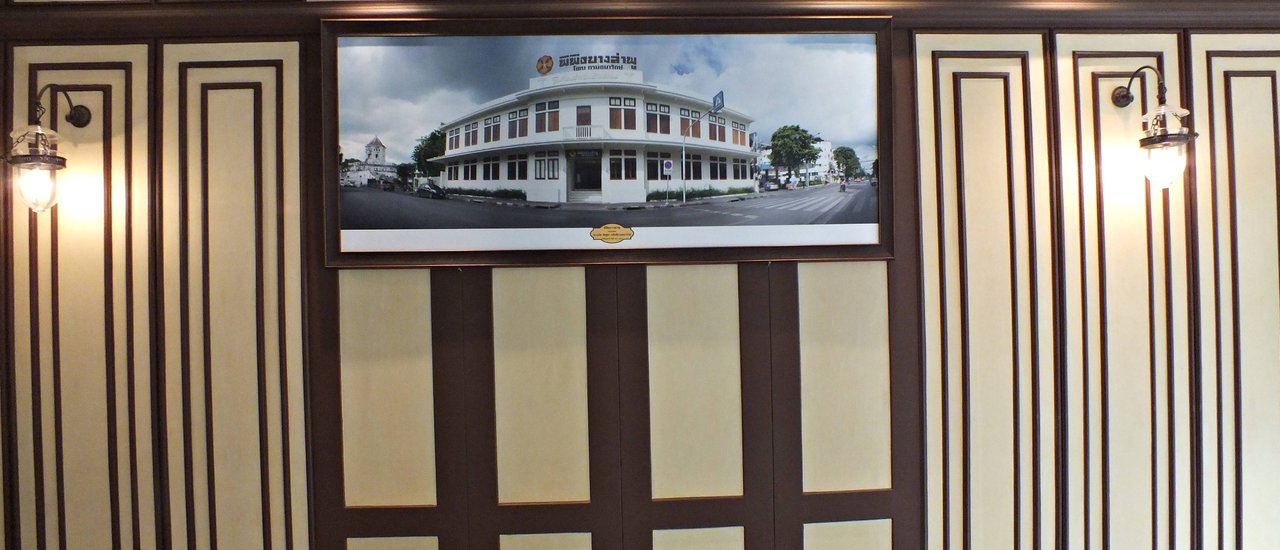On a pleasantly cool Saturday, my elder brother and I found ourselves with errands to run in the Bang Lamphu area. This presented an opportunity to revisit our old haunts, which we had neglected for some time. As we strolled through the Santi Chai Prakan Park and Phra Sumen Fort, we stumbled upon a place we had only ever passed by in a car. Curiosity piqued, we decided to finally explore its interior. This place was the Bang Lamphu Museum.

Before delving into the details, let's first understand what this place is. Research reveals that the "Bang Lamphu Museum" is a modern museum that intriguingly combines historical artifacts and storytelling with the presentation of the traditional Bang Lamphu community's way of life. The learning space is designed with "Universal Design" principles, making it accessible to everyone, including the elderly, people with disabilities, and children. The Treasury Department has renovated the former printing house of the Teachers' Council (Wat Sangwet Printing School), which was the first printing house and training center for printers in Thailand, to become the Treasury Department Museum. It also showcases the history and way of life of the Bang Lamphu community, as well as adding green spaces and activity areas for public use. This is a commendable and innovative concept.

Upon entering, the lush greenery creates a pleasant atmosphere.

Thep Phanom

This tree has a story.
The museum complex comprises two buildings: a concrete L-shaped structure and a wooden building. Each building houses distinct exhibitions. A central green space and an activity plaza connect the two structures. Admission fees apply to both Thai and foreign visitors, with exceptions for children, students in uniform or with valid student ID, monks, novices, nuns, senior citizens aged 60 and above, and individuals with disabilities, who are granted free entry.



Please come inside and contact this counter first.
Upon contacting the staff, we were informed that there is currently no entrance fee, only registration is required. Hearing this, we were relieved and immediately prepared to explore the exhibition. However, the staff informed us that guided tours are available at intervals of 30 minutes. Only the first floor of the concrete building has an exhibition that can be viewed independently. The staff advised us that the next tour would begin in ten minutes. While waiting, we were free to explore the first floor and return to the counter at the appointed time, where the staff would lead us on a guided tour.

The first room is a rotating exhibition, currently showcasing the "Queen Sirikit Exhibition" in honor of Her Majesty's 82nd birthday. The exhibition features several video presentations that highlight Her Majesty's immense contributions to the Thai people, demonstrating her unwavering compassion and dedication, akin to that of our beloved King Rama IX.




The adjacent room is the Fort of Rattanakosin Exhibition, showcasing the history of Rattanakosin, the construction of the city walls, the history of the moats surrounding the city, and the important canals that gave rise to various communities and commercial districts. The exhibition features the history of the city gates, including the gates of the Front Palace and the Grand Palace, as well as the history of the 14 ancient forts surrounding Rattanakosin Island. Unfortunately, I didn't have time to see this room as it was time for the guided tour. Let's move on.


The meeting point is near the counter.
Upon reaching the second floor, visitors will be guided through a permanent exhibition showcasing the history and role of the Treasury Department. The exhibition details the process of coin production and provides insights into the management of royal land.
The first room on display is the "Treasury Department's Mission of Protecting the Dharma," which showcases the roles and responsibilities of the Treasury Department from the past to the present. From being a source of currency for domestic circulation to producing commemorative coins and managing the nation's valuable assets.

The old building of the Treasury Department is also shown in the picture.

The next room, "The Royal Mint Unveiled: Tracing the History of Currency," showcases the coin minting process, the design and development of patterns, and production for circulation to maintain economic balance.



The next room, "Treasures of Pride, Preserved for the Land," showcases the history of the Royal Treasury's collection of valuable assets, as well as the various methods and processes used for their preservation.



Another familiar task we perform in this room is land valuation, which serves the public and the state through the Royal Property and Real Estate Appraisal Department.


We will then be escorted out of the concrete building and onto a wooden structure adjacent to the Bang Lamphu Canal, which is connected by a ramp.


Upon entering, you will find exhibition rooms, starting with the first room, "Colors of Bang Lamphu." Here, you will be seated on the floor against the wall to watch a video that tells the history of the diverse ethnic communities in the early Rattanakosin era. The video also showcases the highlights of Bang Lamphu, such as delicious food spots, public parks for the people of Phra Nakhon, and nighttime entertainment venues. All the images are beautiful.

The image is a bit blurry. He will close the room, so hurry up and go in.

Next is the "Clues from the Canal" room, where a film projected onto the wall creates a simulated surface of the Bang Lamphu Canal, showcasing the diverse ethnicities that coexisted there. The film narrates the stories of the people who lived in this area, including Thais, Mon, Lao, Khmer, Cham, and Chinese.

Visitors then enter the "Phra Nakhon Center" zone, which recreates the way of life of the people of Bang Lamphu in the past. Visitors are invited to cross the Nararat Bridge to enter this zone.


Crossing the bridge, my eyes were drawn to a young child peering through a hole in a corrugated metal fence. Looking through the hole myself, I realized that a likay performance was taking place inside. The guide explained that children in those days did not have enough money to buy tickets to see the likay, so they would peek through holes like this. This was enough entertainment for children of that era.


Curious about what the little girl was peeking at, I had to find a small hole to peek through as well.
In addition, there is the Busayapavanich Cinema, the Homwun Likay Theatre, and the T.Ngek Chuan Department Store. The Thirteen-Shop Street features replicas of several old shops from the Bang Lamphu district, including the Tang Hua Seng shop, the Aun Hiang Liao restaurant, the Kaew Fa shop, and the Noparat clothing shop.


Would you like to buy some movie tickets?

Red Eagles will be screened next week.

The old tram is also recreated for display.

Ngoc Chuan Department Store

The atmosphere of the thirteen shopping malls


Sneaking into a movie screening at the Bhusayaphan Cinema.

Old-fashioned coffee shop

This looks delicious!

Aun Hiang Restaurant

A picture that every household has

The Glass Sky Shop

Tang Hua Seng Restaurant

Napparat Clothing Store
As you continue walking, you will enter the "Yarm Trok Bok Reuang Kao" area, which showcases the hidden treasures of the Bang Lamphu community. This includes symbols of Bang Lamphu that outsiders or younger generations may not be aware of, such as the art of banana stalk piercing, the making of rice porridge with jelly, the Duriyapreenee Thai music house in the Wat Sangwet community, niello work, gold leaf beating, and even the flag shop, which have been integral parts of the Bang Lamphu community for decades.






Niello work

House of Exquisite Music

Products from palm leaves

National Flag Shop, a symbol of Bang Lamphu



Masjid Jamek, the cradle of royal goldsmiths
Continuing on, you will reach the "Land of Good People of Bang Lamphu," which showcases the history of numerous renowned individuals and those who have made significant contributions to society in the Bang Lamphu area.



This map is located in the area we walked into.

The next zone features a replica of the "last remaining Lamphu tree," complete with twinkling lights that resemble fireflies clinging to its branches.

Old pictures can truly tell stories.
Before the end of the exhibition, we will pay our respects to the "Phra Phuttha Bang Lamphu Prachanat," which was originally located at Wat Bowonniwet Vihara. In the past, there was an annual tradition of carrying the statue in a procession around the Bang Lamphu area. However, His Holiness Somdet Phra Yanasangvara, the Supreme Patriarch of Thailand, was concerned that in the future, after his passing, it might be difficult to invite the statue to be carried in a procession around Bang Lamphu as had been the custom. In addition, the construction of the Bang Lamphu Museum was completed at the same time. Therefore, he ordered the statue to be moved and installed there on August 8, 2014, so that the people of Bang Lamphu and visitors could pay their respects and receive blessings for good fortune in the future.

After paying respects to the Buddha statue of Bang Lamphu, the visit to the Bang Lamphu Museum is considered complete. The guide will then lead us downstairs to put on our sandals and walk back to change into our shoes at the concrete building where we left them before entering. However, if anyone has time, they can visit the "Bang Lamphu Community Library" located downstairs, which is a collection of rare books and information about the history of Bang Lamphu, the largest in Thailand.
For Piyai and Noolek, time is up. The tour took quite a while, but it was well worth the hour or so spent at the Bang Lamphu Museum. Not only did it give us a better understanding of the responsibilities of the Treasury Department, but it also gave us a much clearer picture of Bang Lamphu than we had before. It is another valuable place and we must thank everyone involved in creating it to preserve the past of Bang Lamphu so that it can continue to breathe forever. If you have free time, try visiting the "Bang Lamphu Museum". You might understand what I mean by the past that still breathes. Because what I have conveyed here will not be the true breath of Bang Lamphu. The true breath must be felt for oneself. I believe so.
https://www.facebook.com/TravelWithPiyaiAndNoolek/
Piyai&Noolek
Tuesday, October 8, 2024 11:25 AM














